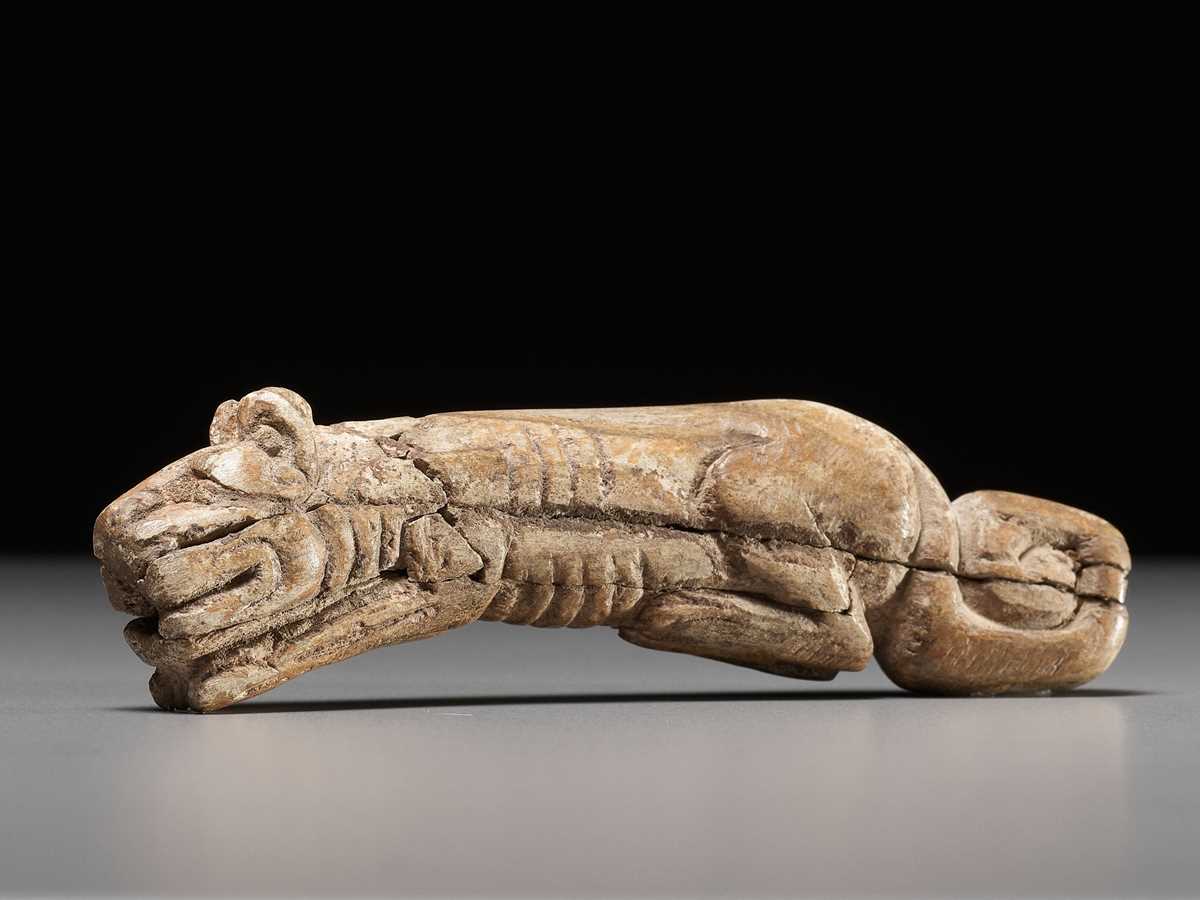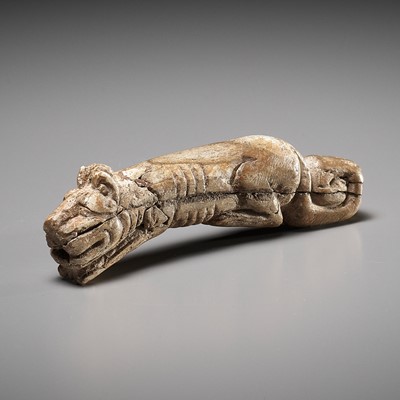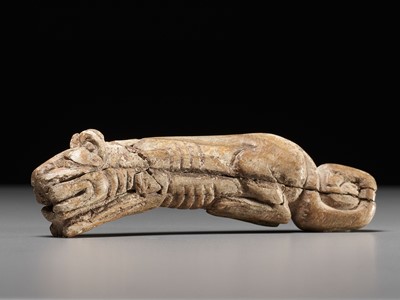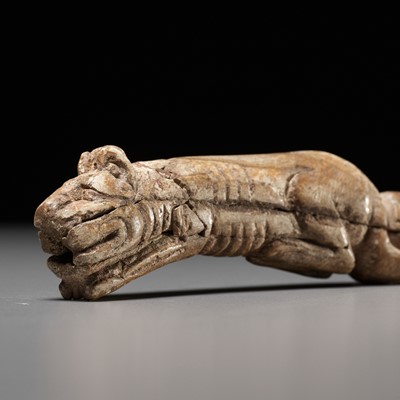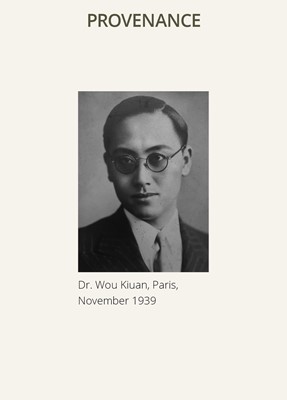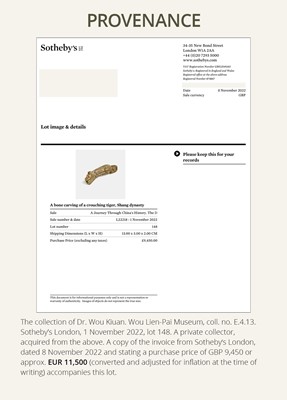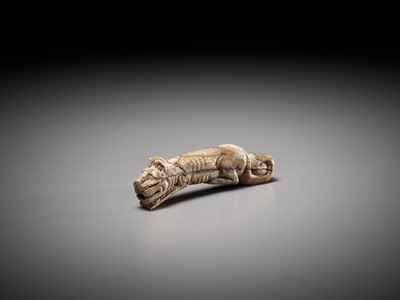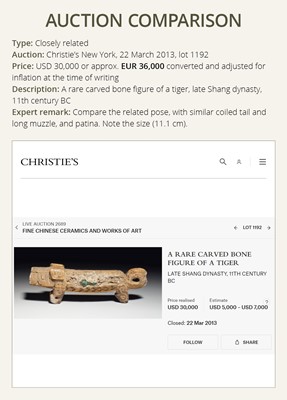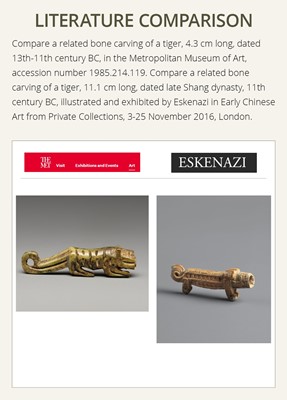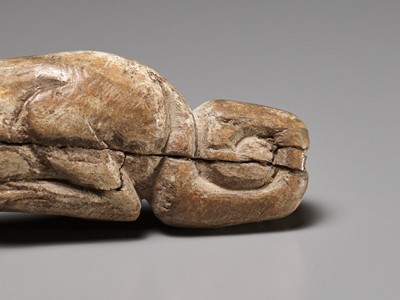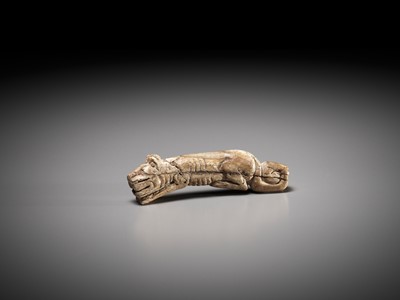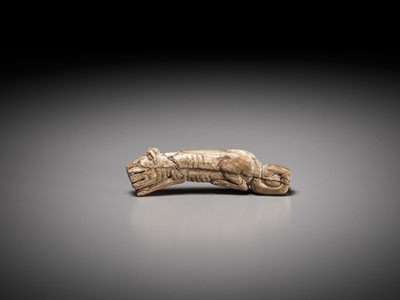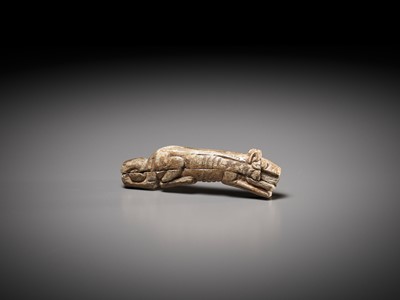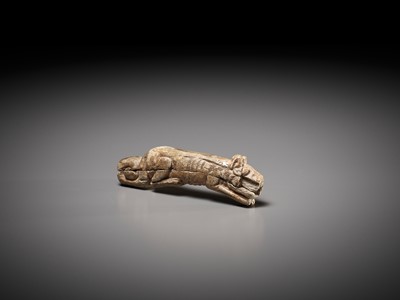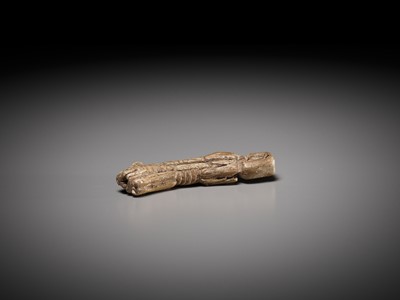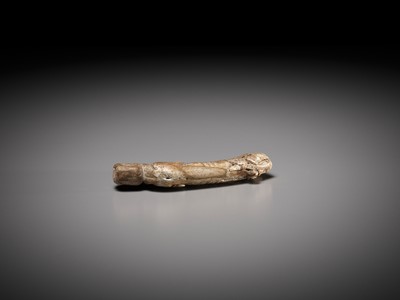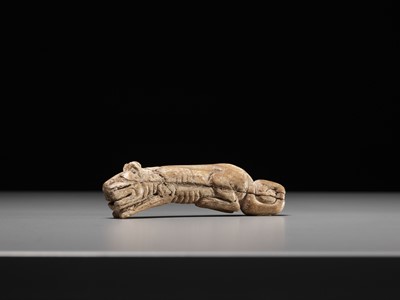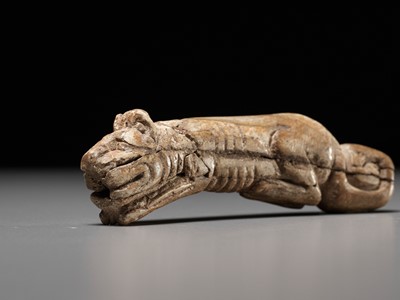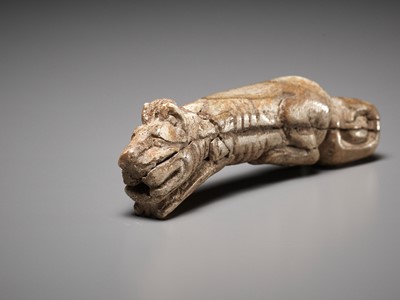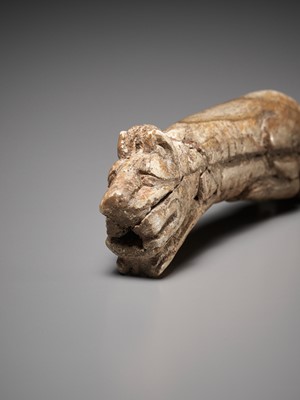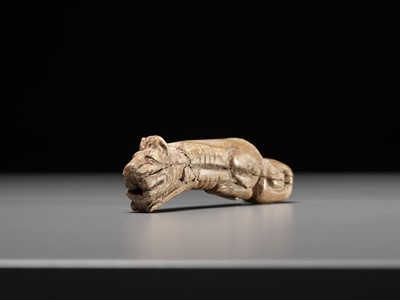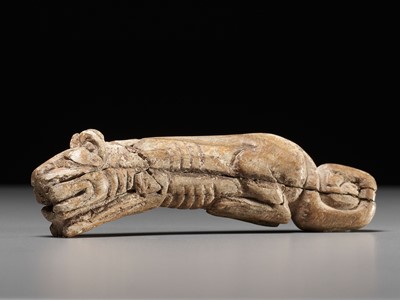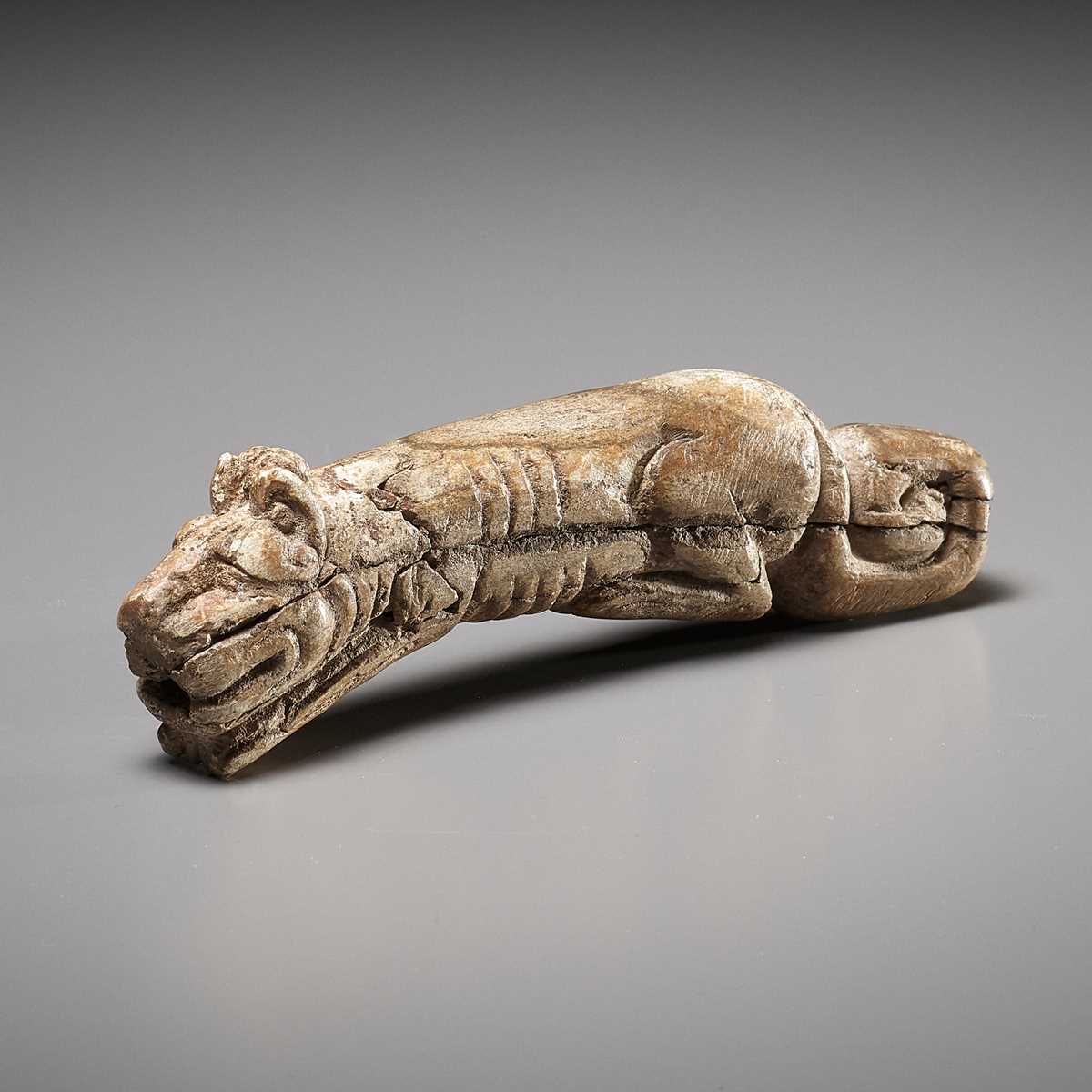1st Mar, 2024 10:00
The No Reserve Dragon Sale
45
A RARE CARVED BONE FIGURE OF A TIGER, SHANG DYNASTY
商代罕見臥虎形骨觿
Sold for €6,500
including Buyer's Premium
Please note this Lot is to be sold at No Reserve. 本拍品不設底價
China, 11th century BC. Well carved in the round as a crouching tiger with tucked-in legs, curled tail and forward-facing head, the rib cage neatly incised, the ears pricked and eyes open in an alert expression. The bone has a superb, naturally grown, warm patina.
Provenance: The collection of Dr. Wou Kiuan. Wou Lien-Pai Museum, coll. no. E.4.13. Sotheby’s London, 1 November 2022, lot 148. A private collector, acquired from the above. A copy of the invoice from Sotheby's London, dated 8 November 2022 and stating a purchase price of GBP 9,450 or approx. EUR 11,500 (converted and adjusted for inflation at the time of writing) accompanies this lot. Dr. Wou Kiuan (1910-1997) was a Chinese diplomat and noted scholar of Chinese art. His father, Wou Lien-Pai (1873-1944), was one the leading political figures of early 20th century China, remembered for his role as speaker and leader of parliament during the turbulent years of the Republican era. Dr. Wou himself embarked on an illustrious career in diplomacy until his retirement in 1952, when he settled in London and devoted the rest of his life to the study of Chinese art. It was without doubt fortuitous that Dr. Wou’s years of collecting coincided with an abundant availability of exceptional Chinese art on the London market. From the mid-1950s to the late 1960s he was able to form a collection of well over 1,000 works that together represented virtually every category of Chinese art. At the heart of Dr. Wou’s drive to collect was a burning desire to preserve the relics of China’s rich historical past scattered across Europe, and to promote Chinese art and culture. It is unclear when Dr. Wou conceived the idea to create a place to house his collection, but in 1968, he opened the doors to the Wou Lien-Pai Museum, named in honor of his father. Over the years, the museum became a ‘must see’ destination for collectors, academics, and visiting dignitaries, and Dr. Wou would delight in leading his visitors through the galleries, recounting stories of China’s glorious history.
Condition: Good condition, commensurate with age. Displaying exceptionally well. Extensive wear, minor losses, chips, expected age cracks and other natural flaws in the bone, minor old repairs, signs of weathering and erosion, encrustations. Note that the patina took more than 3,000 years to develop and therefore is not only spectacular in appearance, but literally one-of-a-kind.
Weight: 61.5 g
Dimensions: Length 12.5 cm
Please click here to read the full description
Bone was widely used for both practical and decorative purposes in ancient China. It was made into vessels, spoons, and personal adornments. With its coiled tail and long muzzle, this bone carving of a tiger was probably used as an amulet or talisman, protecting its wearer from harm and danger.
The tiger, called hu or laohu in Chinese, is among the most recognizable of the world’s charismatic megafauna. Originating in China and northern Central Asia, the tiger was known to the earliest Chinese, who likely feared, admired, and respected it for its strength, ferocity, and regal bearing. Though its precise symbolism in Shang times (c. 1600–c. 1046 BC) remains unknown, the tiger doubtless played a totemic, tutelary, or talismanic role. By the Western Han period (206 BC–AD 9) – a thousand years after this pendant was made – the tiger was regarded as the ‘king of the hundred beasts’, or baishou zhi wang, due to its power and ferocity and especially for the markings on its forehead which typically resemble the character wang, or ‘king’. In addition, not only did the tiger figure among the twelve animals of the Chinese zodiac, but it gained a place among the auspicious animals that symbolize the four cardinal directions – the White Tiger, or baihu, of the west, the Azure Dragon of the east, the Vermilion Bird of the south, and the Black Tortoise of the north.
Literature comparison:
Compare a related bone carving of a tiger, 4.3 cm long, dated 13th-11th century BC, in the Metropolitan Museum of Art, accession number 1985.214.119. Compare a related bone carving of a tiger, 11.1 cm long, dated late Shang dynasty, 11th century BC, illustrated and exhibited by Eskenazi in Early Chinese Art from Private Collections, 3-25 November 2016, London.
Auction result comparison:
Type: Closely related
Auction: Christie’s New York, 22 March 2013, lot 1192
Price: USD 30,000 or approx. EUR 36,000 converted and adjusted for inflation at the time of writing
Description: A rare carved bone figure of a tiger, late Shang dynasty, 11th century BC
Expert remark: Compare the related pose, with similar coiled tail and long muzzle, and patina. Note the size (11.1 cm).
点此阅读中文翻译 (Chinese Translation)
商代罕見臥虎形骨觿
中國,公元前十一世紀。該虎為長條形,張口露齒,方眼短角,長身卷尾,四肢前屈,作伏臥狀。自然包漿,色澤溫暖。
來源:吳權博士收藏;吳權(1910-1997)博士曾是一位中國外交家以及知名中國藝術收藏家。他的父親吳蓮伯 (1873-1944)先生曾是二十世紀初中國重要政治人物,因在民國動蕩歲月中擔任國會議員及議長而聞名。1952 年,吳博士在外交領域走上了輝煌之路,直到他退休後定居倫敦,並將餘生奉獻給了對中國藝術的研究。毫無疑問,吳權博士多年的收藏,與大量中國藝術珍品現身倫敦藝術市場上時間點相呼應,這無疑是幸運的。從 1950 年代中期到 1960 年代後期,他收集了 1,000 多件藏品,涵蓋了中國藝術的每一個門類。吳博士之所以收藏,其原因主要是爲保護散落歐洲各地的中國文物與推廣中國藝術與文化。尚不清楚吳博士何時想到創建一個美術館來歸置他的收藏的,但在 1968 年,他打開了以他父親的名字命名的 吳蓮伯美術館的大門。多年來,美術館已成為收藏家、學者和來訪政要的必經之地,而吳博士總是很樂意給參觀者介紹美術館,講述中國光輝歷史的故事。
品相:品相良好,大面積磨損、輕微缺損、預期的年代裂縫和骨骼中的其他自然缺陷,輕微的小修、風化和侵蝕的跡象、結殼。請注意,包漿經過3,000 多年才形成,外觀獨特。
重量:61.5 克
尺寸:長 12.5 厘米
骨器古代出土的遺物中佔有重要地位,種類多樣,用途廣泛,製造成各種生活用器、生產工具、武器、樂器、裝飾品、雕刻藝術品和其他雜器等。
老虎被視為“百獸之王”,古時中國人就知道老虎,他們可能害怕、欽佩和尊重它的力量、兇猛和帝王般的氣度。雖然它在商代(西元前 1600 年至西元前 1046 年)的確切象徵意義仍然未知,但無疑扮演了圖騰、守護或護身符的角色。到了西漢時期(西元前 206 年 - 西元 9 年)此外,老虎不僅在十二生肖中佔有一席之地,而且在像徵四方位的吉祥動物:西方的白虎、東方的青龍,南方朱雀,北方烏龜。
文獻比較:
比較一件相近的公元前十三至十一世紀臥虎形骨觿,4.3 厘米長,收藏於大都會藝術博物館,館藏編號1985.214.119。比較一件相近的公元前十一世紀商代晚期臥虎形骨觿,11.1 厘米長,展於倫敦《Eskenazi in Early Chinese Art from Private Collections》,2016年11月3-25日。
拍賣結果比較:
形制:非常相近
拍賣:紐約佳士得,2013年3月22日, lot 1192
價格:USD 30,000(相當於今日EUR 36,000)
描述:晚商骨雕虎形把件
專家評論:比較相近的姿勢和捲曲的尾巴,以及包漿。請注意尺寸(11.1 厘米)。
Please note this Lot is to be sold at No Reserve. 本拍品不設底價
China, 11th century BC. Well carved in the round as a crouching tiger with tucked-in legs, curled tail and forward-facing head, the rib cage neatly incised, the ears pricked and eyes open in an alert expression. The bone has a superb, naturally grown, warm patina.
Provenance: The collection of Dr. Wou Kiuan. Wou Lien-Pai Museum, coll. no. E.4.13. Sotheby’s London, 1 November 2022, lot 148. A private collector, acquired from the above. A copy of the invoice from Sotheby's London, dated 8 November 2022 and stating a purchase price of GBP 9,450 or approx. EUR 11,500 (converted and adjusted for inflation at the time of writing) accompanies this lot. Dr. Wou Kiuan (1910-1997) was a Chinese diplomat and noted scholar of Chinese art. His father, Wou Lien-Pai (1873-1944), was one the leading political figures of early 20th century China, remembered for his role as speaker and leader of parliament during the turbulent years of the Republican era. Dr. Wou himself embarked on an illustrious career in diplomacy until his retirement in 1952, when he settled in London and devoted the rest of his life to the study of Chinese art. It was without doubt fortuitous that Dr. Wou’s years of collecting coincided with an abundant availability of exceptional Chinese art on the London market. From the mid-1950s to the late 1960s he was able to form a collection of well over 1,000 works that together represented virtually every category of Chinese art. At the heart of Dr. Wou’s drive to collect was a burning desire to preserve the relics of China’s rich historical past scattered across Europe, and to promote Chinese art and culture. It is unclear when Dr. Wou conceived the idea to create a place to house his collection, but in 1968, he opened the doors to the Wou Lien-Pai Museum, named in honor of his father. Over the years, the museum became a ‘must see’ destination for collectors, academics, and visiting dignitaries, and Dr. Wou would delight in leading his visitors through the galleries, recounting stories of China’s glorious history.
Condition: Good condition, commensurate with age. Displaying exceptionally well. Extensive wear, minor losses, chips, expected age cracks and other natural flaws in the bone, minor old repairs, signs of weathering and erosion, encrustations. Note that the patina took more than 3,000 years to develop and therefore is not only spectacular in appearance, but literally one-of-a-kind.
Weight: 61.5 g
Dimensions: Length 12.5 cm
Please click here to read the full description
Bone was widely used for both practical and decorative purposes in ancient China. It was made into vessels, spoons, and personal adornments. With its coiled tail and long muzzle, this bone carving of a tiger was probably used as an amulet or talisman, protecting its wearer from harm and danger.
The tiger, called hu or laohu in Chinese, is among the most recognizable of the world’s charismatic megafauna. Originating in China and northern Central Asia, the tiger was known to the earliest Chinese, who likely feared, admired, and respected it for its strength, ferocity, and regal bearing. Though its precise symbolism in Shang times (c. 1600–c. 1046 BC) remains unknown, the tiger doubtless played a totemic, tutelary, or talismanic role. By the Western Han period (206 BC–AD 9) – a thousand years after this pendant was made – the tiger was regarded as the ‘king of the hundred beasts’, or baishou zhi wang, due to its power and ferocity and especially for the markings on its forehead which typically resemble the character wang, or ‘king’. In addition, not only did the tiger figure among the twelve animals of the Chinese zodiac, but it gained a place among the auspicious animals that symbolize the four cardinal directions – the White Tiger, or baihu, of the west, the Azure Dragon of the east, the Vermilion Bird of the south, and the Black Tortoise of the north.
Literature comparison:
Compare a related bone carving of a tiger, 4.3 cm long, dated 13th-11th century BC, in the Metropolitan Museum of Art, accession number 1985.214.119. Compare a related bone carving of a tiger, 11.1 cm long, dated late Shang dynasty, 11th century BC, illustrated and exhibited by Eskenazi in Early Chinese Art from Private Collections, 3-25 November 2016, London.
Auction result comparison:
Type: Closely related
Auction: Christie’s New York, 22 March 2013, lot 1192
Price: USD 30,000 or approx. EUR 36,000 converted and adjusted for inflation at the time of writing
Description: A rare carved bone figure of a tiger, late Shang dynasty, 11th century BC
Expert remark: Compare the related pose, with similar coiled tail and long muzzle, and patina. Note the size (11.1 cm).
点此阅读中文翻译 (Chinese Translation)
商代罕見臥虎形骨觿
中國,公元前十一世紀。該虎為長條形,張口露齒,方眼短角,長身卷尾,四肢前屈,作伏臥狀。自然包漿,色澤溫暖。
來源:吳權博士收藏;吳權(1910-1997)博士曾是一位中國外交家以及知名中國藝術收藏家。他的父親吳蓮伯 (1873-1944)先生曾是二十世紀初中國重要政治人物,因在民國動蕩歲月中擔任國會議員及議長而聞名。1952 年,吳博士在外交領域走上了輝煌之路,直到他退休後定居倫敦,並將餘生奉獻給了對中國藝術的研究。毫無疑問,吳權博士多年的收藏,與大量中國藝術珍品現身倫敦藝術市場上時間點相呼應,這無疑是幸運的。從 1950 年代中期到 1960 年代後期,他收集了 1,000 多件藏品,涵蓋了中國藝術的每一個門類。吳博士之所以收藏,其原因主要是爲保護散落歐洲各地的中國文物與推廣中國藝術與文化。尚不清楚吳博士何時想到創建一個美術館來歸置他的收藏的,但在 1968 年,他打開了以他父親的名字命名的 吳蓮伯美術館的大門。多年來,美術館已成為收藏家、學者和來訪政要的必經之地,而吳博士總是很樂意給參觀者介紹美術館,講述中國光輝歷史的故事。
品相:品相良好,大面積磨損、輕微缺損、預期的年代裂縫和骨骼中的其他自然缺陷,輕微的小修、風化和侵蝕的跡象、結殼。請注意,包漿經過3,000 多年才形成,外觀獨特。
重量:61.5 克
尺寸:長 12.5 厘米
骨器古代出土的遺物中佔有重要地位,種類多樣,用途廣泛,製造成各種生活用器、生產工具、武器、樂器、裝飾品、雕刻藝術品和其他雜器等。
老虎被視為“百獸之王”,古時中國人就知道老虎,他們可能害怕、欽佩和尊重它的力量、兇猛和帝王般的氣度。雖然它在商代(西元前 1600 年至西元前 1046 年)的確切象徵意義仍然未知,但無疑扮演了圖騰、守護或護身符的角色。到了西漢時期(西元前 206 年 - 西元 9 年)此外,老虎不僅在十二生肖中佔有一席之地,而且在像徵四方位的吉祥動物:西方的白虎、東方的青龍,南方朱雀,北方烏龜。
文獻比較:
比較一件相近的公元前十三至十一世紀臥虎形骨觿,4.3 厘米長,收藏於大都會藝術博物館,館藏編號1985.214.119。比較一件相近的公元前十一世紀商代晚期臥虎形骨觿,11.1 厘米長,展於倫敦《Eskenazi in Early Chinese Art from Private Collections》,2016年11月3-25日。
拍賣結果比較:
形制:非常相近
拍賣:紐約佳士得,2013年3月22日, lot 1192
價格:USD 30,000(相當於今日EUR 36,000)
描述:晚商骨雕虎形把件
專家評論:比較相近的姿勢和捲曲的尾巴,以及包漿。請注意尺寸(11.1 厘米)。
Zacke Live Online Bidding
Our online bidding platform makes it easier than ever to bid in our auctions! When you bid through our website, you can take advantage of our premium buyer's terms without incurring any additional online bidding surcharges.
To bid live online, you'll need to create an online account. Once your account is created and your identity is verified, you can register to bid in an auction up to 12 hours before the auction begins.
Intended Spend and Bid Limits
When you register to bid in an online auction, you will need to share your intended maximum spending budget for the auction. We will then review your intended spend and set a bid limit for you. Once you have pre-registered for a live online auction, you can see your intended spend and bid limit by going to 'Account Settings' and clicking on 'Live Bidding Registrations'.
Your bid limit will be the maximum amount you can bid during the auction. Your bid limit is for the hammer price and is not affected by the buyer’s premium and VAT. For example, if you have a bid limit of €1,000 and place two winning bids for €300 and €200, then you will only be able to bid €500 for the rest of the auction. If you try to place a bid that is higher than €500, you will not be able to do so.
Online Absentee and Telephone Bids
You can now leave absentee and telephone bids on our website!
Absentee Bidding
Once you've created an account and your identity is verified, you can leave your absentee bid directly on the lot page. We will contact you when your bids have been confirmed.
Telephone Bidding
Once you've created an account and your identity is verified, you can leave telephone bids online. We will contact you when your bids have been confirmed.
Classic Absentee and Telephone Bidding Form
You can still submit absentee and telephone bids by email or fax if you prefer. Simply fill out the Absentee Bidding/Telephone bidding form and return it to us by email at office@zacke.at or by fax at +43 (1) 532 04 52 20. You can download the PDF from our Upcoming Auctions page.
How-To Guides
How to Create Your Personal Zacke Account
How to Register to Bid on Zacke Live
How to Leave Absentee Bids Online
How to Leave Telephone Bids Online
中文版本的操作指南
创建新账号
注册Zacke Live在线直播竞拍(免平台费)
缺席投标和电话投标
Third-Party Bidding
We partner with best-in-class third-party partners to make it easy for you to bid online in the channel of your choice. Please note that if you bid with one of our third-party online partners, then there will be a live bidding surcharge on top of your final purchase price. You can find all of our fees here. Here's a full list of our third-party partners:
- 51 Bid Live
- EpaiLive
- ArtFoxLive
- Invaluable
- LiveAuctioneers
- the-saleroom
- lot-tissimo
- Drouot
Please note that we place different auctions on different platforms. For example, in general, we only place Chinese art auctions on 51 Bid Live.
Bidding in Person
You must register to bid in person and will be assigned a paddle at the auction. Please contact us at office@zacke.at or +43 (1) 532 04 52 for the latest local health and safety guidelines.
